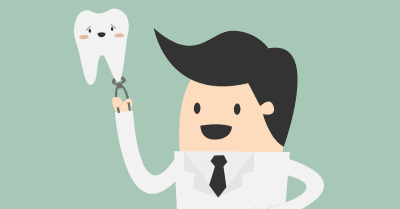Extraction

What is tooth extraction?
Tooth extraction is the removal of a tooth from its socket in the bone.
Types of extractions
- A simple extraction is performed on a tooth that can be seen in the mouth.
- A surgical extraction is a more complex procedure. It is used if a tooth may have broken off at the gum line or has not come into the mouth yet. The doctor makes a small incision (cut) into your gum. Sometimes it’s necessary to remove some of the bone around the tooth or to cut the tooth in half in order to extract it.
Reason to extract tooth
- Damaged tooth by decay or large broken old filling
- Very loose tooth
- Extra teeth that block other teeth from coming in.
- Baby teeth don’t fall out in time
- People getting braces may need teeth extracted
- People receiving radiation to the head and neck may need to have teeth in the field of radiation extracted.
- People receiving cancer drugs may develop infected teeth because these drugs weaken the immune system. Infected teeth may need to be extracted.
- Wisdom teeth, also called third molars, are often extracted either before or after they come in. These teeth often get stuck in the jaw (impacted) and do not come in. This can irritate the gum, causing pain and swelling. In this case, the tooth must be removed.
Preparation
- An X-ray of the area will be taken to help plan the best way to remove the tooth.
- Some doctors prescribe antibiotics to be taken before and after surgery. This practice varies by the dentist or oral surgeon.
- Do not smoke on the day of surgery. This can increase the risk of a painful problem called dry socket.
After an extraction,
- Bite on a piece of gauze for 20 to 30 minutes. This pressure will allow the blood to clot. You will still have a small amount of bleeding for the next 24 hours or so. It should taper off after that. Don’t disturb the clot that forms on the wound.
- If you have any questions, make sure to ask them before you leave the office.
- Some discomfort can be expected after even simple extractions. Usually it is mild. Taking nonsteroidal anti-inflammatory drugs (NSAIDs) can greatly decrease pain after a tooth extraction. These drugs include ibuprofen, such as Advil, Motrin and others.
- You can put ice packs on your face to reduce swelling. Typically, they are left on for 20 minutes at a time and removed for 20 minutes. If your jaw is sore and stiff after the swelling goes away, try warm compresses.
- Eat soft and cool foods for a few days. Then try other food as you feel comfortable.
- You should not smoke, use a straw or spit after surgery. These actions can pull the blood clot out of the hole where the tooth was. Do not smoke on the day of surgery. Do not smoke for 24 to 72 hours after having a tooth extracted.
Risks
- Dry socket occurs when a blood clot doesn’t form in the hole or the blood clot breaks off or breaks down too early.In a dry socket, the underlying bone is exposed to air and food. This can be very painful and can cause a bad odor or taste. Typically dry sockets begin to cause pain the third day after surgery. Smokers and women who take birth control pills are more likely to have a dry socket. Smoking on the day of surgery further increases the risk. A dry socket needs to be treated with a medicated dressing to stop the pain and encourage the area to heal.
- Accidental damage to nearby teeth, such as fracture of fillings or teeth
- An incomplete extraction, in which a tooth root remains in the jaw —
- A fractured jaw caused by the pressure put on the jaw during extraction
- A hole in the sinus during removal of an upper back tooth (molar)
- Soreness in the jaw muscles and/or jaw joint —
- Long-lasting numbness in the lower lip and chin — This is an uncommon problem. It is caused by injury to the inferior alveolar nerve in your lower jaw. Complete healing may take three to six months. In rare cases, the numbness may be permanent.








